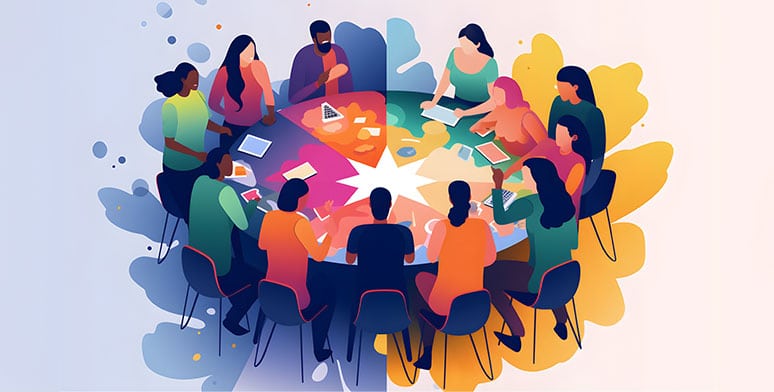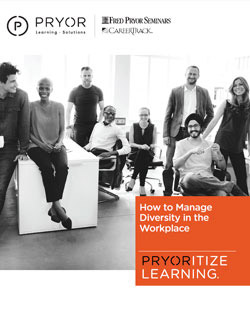Diversity, Equity and Inclusion (DEI): Starting with Recruiting

Perspectives and tools for building diversity, equity and inclusion (DEI) continue to evolve in organizations, as more people are part of the conversations that truly encourage employee engagement, a positive work environment and a sense of belonging. In this article, we consider how these outcomes are best supported through effective recruiting and hiring work.
Starting with Recruiting: Reaching More Broadly
Additive diversity refers to the dimensions of diversity that build and expand upon the strengths the organization has – by engaging people with different perspectives and histories. Recruiting and onboarding processes are critical for supporting additive diversity and DEI. If we continue to hire people who are like the people already here, it is hard to gain the benefits gained from differences.
People have multiple layers of diversity that intersect and interact to shape their identities and experiences. These different identities and experiences help organizations achieve their missions in new ways, and effectively serve a wider diversity of customers.
SAVE $10 AND TRAIN ON THIS TOPIC TODAY
What does additive diversity have to do with recruiting? One important source of diversity is socioeconomic status, which has to do with differences based on economic factors. Differences in socioeconomic status can have a significant impact in the hiring process and may be a source of unconscious bias for an organization. Here are some examples:
- Networking and Connections: Many organizations use referral programs to hire people, because a good hire can recognize another good hire. However, this may lead to less socioeconomic diversity because individuals from lower socioeconomic backgrounds may have less access to the professional networks and insider connections that lead to such referrals.
- Recruiting Methods: Recruiters tend to have their favorite recruiting sources – certain job boards or association or school networks. These sources may be more accessible to people with a higher socioeconomic level, so it is useful to consider other sources to reach out to when advertising positions.
- Entry Level Experience: Many industries and professions value candidates with internship or volunteer experience. However, individuals from lower socioeconomic backgrounds may face barriers to gaining these experiences due to financial constraints. Organizations may benefit from rethinking their career development ladders to invite in more people at entry level, who have not had the opportunities others have had to build their resumes.
- Geographic Mobility: Economic factors, such as housing affordability and cost of living, can impact individuals’ geographic mobility – impacting the ability of candidates to go to an in-person job interview, or commute a long distance every day. Organizations offering virtual interviews, relocation expenses, tuition support benefits, flexible work schedules or remote or hybrid opportunities may find there are more candidates from diverse backgrounds who are able to engage in the process.
- Access to Specialized Development: Are you hiring for preexisting skills or the ability to learn and contribute? Individuals from lower socioeconomic backgrounds may not walk in with all the specialized skills on Day 1. Focusing on hiring people with transferable skills and the ability to learn may require more investment during onboarding but may provide additive diversity that yields benefits in many other organizational areas.
Socioeconomic status is a part of intersectional diversity – economic differences exist alongside differences in race, gender, sexual orientation, region and age. Establishing recruiting approaches that are sensitive to socioeconomic differences facilitates broader DEI efforts, because it likely leads to more diverse candidates who are considering joining your organization and supporting your mission.
Engaging Everyone: Inviting Marginalized Groups
When designing or deepening recruiting efforts, it is also important to consider ways to engage marginalized groups. In a DEI context, marginal groups refer to social groups who have traditionally experienced systematic, institutional or societal barriers that prevent them from fully participating in or accessing resources and opportunities. In addition to socioeconomic status, discussed above, these groups may have disadvantages due to race, ethnicity, gender identity, sexual orientation, disability, religion and/or age.
Here’s a breakdown of what marginalized groups mean within the DEI framework. Understanding these characteristics helps organizations design recruiting, onboarding and engagement approaches that avoid unconscious bias and support diversity at all levels.
- Social Disadvantage: Marginalized groups are often subject to social disadvantage due to historical or ongoing discrimination, prejudice and unequal power dynamics. This disadvantage can manifest in various aspects of life, including employment, education, healthcare, housing and legal rights. Reaching out to a range of sources during recruiting efforts helps reach people with different levels of social advantage.
- Limited Access: Marginalized groups may face barriers that limit their access to opportunities, resources and services. These barriers can be structural, such as a lack of or cumbersome accommodations, or they can be societal, stemming from stereotypes, biases and systemic inequalities. For example, how difficult would it be for a disabled employees to navigate your organization’s physical layout and information resources? By not investing in accessibility, organizations can inadvertently limit access.
- Underrepresentation: Marginalized groups are frequently underrepresented in positions of power, leadership roles and decision-making bodies. When candidates look at the leadership profiles on your organization’s website, what types of diversity do they see – what diverse experiences and backgrounds are captured there? A more diverse leadership team signals to candidates that they may find a greater sense of belonging compared to other organizations.
In DEI initiatives, addressing the needs and concerns of marginalized groups is essential for promoting equity, inclusivity and a sense of belonging. This involves recognizing and dismantling systemic barriers, amplifying a range of voices, advocating for policy changes where needed, providing support and resources, and actively working to create environments where all candidates and employees are valued and have the tools to contribute to and achieve the organization’s mission.
After Day 1: 10 Steps for Engagement and Belonging
Once an organization has invested in expanding its recruiting work to be more inclusive of people of all socioeconomic levels, and to increase its representation of marginalized groups, it is vital to foster a positive work environment and sense of belonging that makes people want to stay. Here are 10 steps organizations can take to do this.
- Gather Information and Listen: Conduct listening sessions, focus groups or surveys to gather feedback from employees. Create space for open dialogue and active listening, and use the feedback to inform decision-making and program development.
- Accessible Outreach: Ensure organizational outreach efforts are accessible and inclusive. This may involve using multiple communication channels, including online platforms, social media, community events and grassroots outreach strategies. Provide information in multiple languages and formats to reach a diverse audience.
- Community Partnerships: Establish partnerships with community organizations and non-profits that represent and serve a range of people important to your organization and community. Collaborate on initiatives, events and programs that address shared needs and priorities.
- Financial Accessibility: Consider offering paid internships, scholarships, or tuition/loan repayment programs to ensure that marginalized individuals and those with lower socioeconomic status have more options for engaging with your organization’s recruiting efforts in the long-term. Today’s high school intern could become a loyal Vice President someday.
- Representation and Leadership: Work to build a leadership team and advisory and engagement groups where diverse voices are represented at all levels of the organization. Watch out for unconscious bias when recruiting for leadership development programs – and publish clear criteria for transparency and accountability.
- Skills Development and Training: Provide skills development, training, and mentorship programs to develop all facets of an employee’s engagement with the workforce – not just technical skills for a specific position. Examples include workshops on topics such as resume writing, interview skills, financial literacy and career development.
- Cultural Competency and Sensitivity: Ensure that DEI initiatives and all programs are culturally competent and sensitive to the unique experiences, identities and challenges across a range of employees.
- Support Volunteer Work: When possible, encourage and provide time for employees to lead and participate in community initiatives that address their interests. These efforts give back to the community and develop employee skills that are vital for mission achievement – like communication, interpersonal skills, and project management.
- Continuous Feedback and Evaluation: Solicit ongoing feedback and input to ensure that organization initiatives are responsive to a range of evolving needs and priorities. Regularly evaluate the impact and effectiveness of programs and initiatives and make adjustments as needed based on feedback and insights.
- Visibility and Recognition: Celebrate and highlight the contributions, achievements, and voices of all employees. Showcase a wide range of stories, experiences, and perspectives through media, events and publications to promote visibility, recognition and empowerment.
Some of these actions require extra resources – but some do not. And some that may cost money now come with likely benefits far into the future. Diversity supports mission – considering how they work together can often point to the most important tangible and intangible investments.
Next Steps: Building DEI Skills
Pryor offers many resources to support your DEI work, including virtual and in-person team training on How to Manage Diversity in the Workplace and Understanding and Developing Cultural Diversity. Virtual seminars include Diversity, Equity and Inclusion in the Workplace and Why Diversity Matters and How to Recognize and Overcome Unconscious Bias. We also offer a digital download on Neurodiversity, and several blog articles to deepen awareness and expand your skills in DEI.



